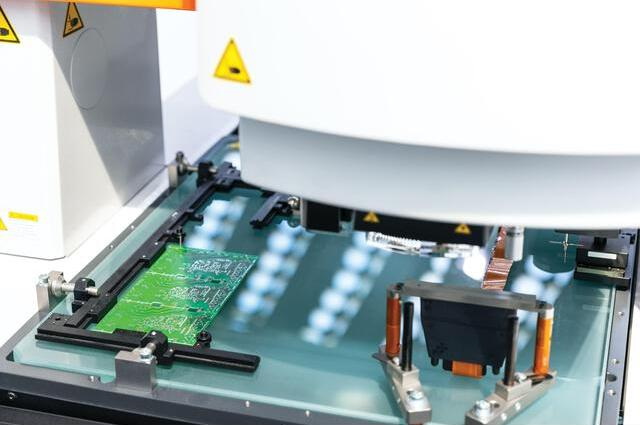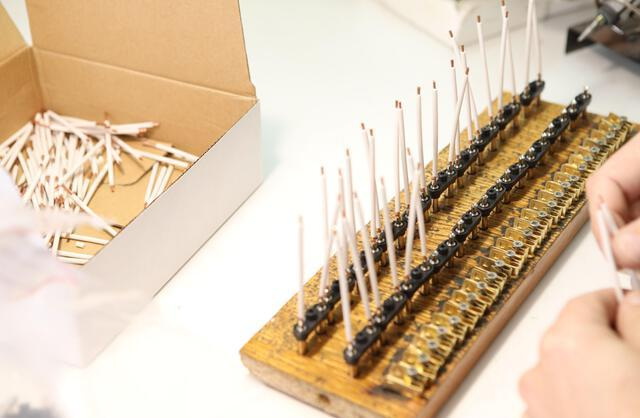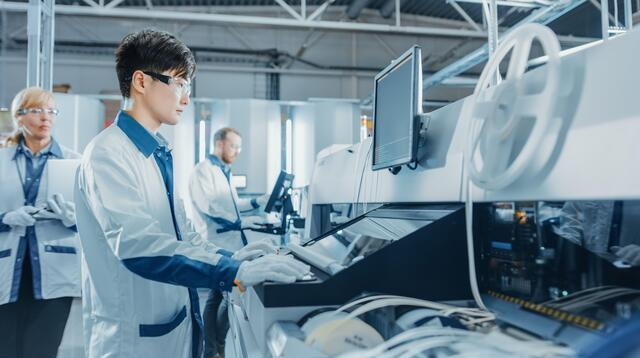Content Menu
● Introduction
● What is SMT Line Communication?
● Key Benefits of SMT Line Communication
>> 1. Enhanced Production Speed
>> 2. Improved Quality Control
>> 3. Cost Efficiency
>> 4. Flexibility and Scalability
>> 5. Compact and Lightweight Designs
>> 6. Enhanced Reliability and Performance
● Case Studies and Real-World Applications
● Challenges and Solutions in SMT Line Communication
● Future Trends Influencing SMT Line Communication
>> 1. Integration of Artificial Intelligence (AI)
>> 2. Automation and Robotics
>> 3. Sustainability Practices
>> 4. Digital Twin Technology
>> 5. Enhanced Data Analytics
● Conclusion
● FAQ
>> 1. What is SMT line communication?
>> 2. How does SMT improve production efficiency?
>> 3. What are the cost benefits of SMT?
>> 4. What challenges exist in SMT line communication?
>> 5. What industries benefit most from SMT?
● Citations:
Introduction
Surface Mount Technology (SMT) line communication has transformed the manufacturing landscape, particularly in the production of printed circuit boards (PCBs). By integrating advanced automation and communication systems, SMT lines have become essential in modern manufacturing, offering unmatched efficiency and precision. This article delves into how SMT line communication enhances production efficiency, its key benefits, challenges, and practical applications.

What is SMT Line Communication?
SMT line communication refers to the interconnected automated systems that streamline the PCB assembly process. These systems comprise various components, including:
- Solder Paste Printers: Apply solder paste to PCB pads.
- Pick-and-Place Machines: Accurately place components onto the boards.
- Reflow Ovens: Melt solder to create electrical connections.
- Automated Optical Inspection (AOI): Inspect boards for defects post-assembly.
By facilitating seamless communication between these components, manufacturers can achieve higher accuracy, faster production times, and reduced error rates.
Key Benefits of SMT Line Communication
1. Enhanced Production Speed
Automation in SMT lines allows for rapid component placement on PCBs, significantly increasing throughput. Advanced machinery can handle thousands of components per hour, making it ideal for high-volume production. This speed is crucial in meeting market demands and reducing time-to-market for electronic products.
2. Improved Quality Control
Automated inspection systems like AOI and X-ray inspection play a pivotal role in identifying defects early in the production process. This ensures that only high-quality products reach the market, minimizing the need for costly rework and enhancing customer satisfaction.
3. Cost Efficiency
By automating labor-intensive tasks, SMT lines reduce reliance on manual labor, leading to lower operational costs. Furthermore, the precision of automated systems minimizes material waste, further enhancing cost efficiency. Companies can achieve significant savings while maintaining high production standards.
4. Flexibility and Scalability
SMT lines are highly adaptable, capable of handling various component sizes and types. This flexibility allows manufacturers to switch between different product designs with minimal downtime, making it easier to scale production as needed. As market demands shift, companies can quickly adjust their operations without significant disruptions.
5. Compact and Lightweight Designs
One of the most significant advantages of SMT is its ability to create smaller and lighter assemblies. Components used in SMT are typically smaller than their through-hole counterparts, enabling the production of compact devices like smartphones, wearables, and IoT gadgets. This miniaturization is crucial for industries where space is at a premium.
6. Enhanced Reliability and Performance
SMT components are soldered directly onto the PCB surface, resulting in better electrical performance and fewer mechanical failures. The absence of lead wires and minimized interconnections reduce the likelihood of signal interference and resistance issues. This leads to improved signal integrity and durability, making SMT assemblies more reliable under various conditions.
Case Studies and Real-World Applications
Numerous companies have successfully implemented SMT line communication to improve their production processes. For example:
- Rauland, a division of AMETEK Inc., implemented process improvements in their SMT lines that resulted in a 50% reduction in defects and a 20% increase in throughput. These advancements saved the company $1 million annually across three SMT lines.
Such case studies illustrate the tangible benefits of adopting SMT line communication strategies.
Challenges and Solutions in SMT Line Communication
Despite its advantages, SMT line communication is not without challenges. Common issues include:
- Equipment Downtime: Regular maintenance schedules and predictive maintenance technologies can help minimize downtime.
- High Defect Rates: Implementing advanced training programs for operators and utilizing machine learning for quality control can significantly reduce defect rates.
- Need for Skilled Operators: Continuous training and development programs ensure that operators are well-equipped to handle advanced technologies.
Addressing these challenges is crucial for maximizing the benefits of SMT line communication.

Future Trends Influencing SMT Line Communication
The future of SMT line communication is shaped by several emerging trends:
1. Integration of Artificial Intelligence (AI)
AI technologies are increasingly being integrated into SMT processes to enhance decision-making capabilities. AI can optimize component placement by analyzing vast amounts of data to ensure accurate positioning while enabling real-time fault detection during assembly processes.
2. Automation and Robotics
The continued advancement of automation technologies means that more tasks within the SMT line will be performed by robots capable of precise component placement, soldering, and inspection tasks. This not only boosts productivity but also reduces human error.
3. Sustainability Practices
As environmental concerns grow, sustainability has become a crucial focus in electronics manufacturing, including SMT production lines. Manufacturers are adopting eco-friendly practices such as using lead-free soldering materials, implementing energy-efficient processes, and reducing waste generation.
4. Digital Twin Technology
Digital twin technology allows manufacturers to create virtual models of their production processes to simulate operations before implementation. This technology helps identify potential inefficiencies or issues before they arise in real-world applications.
5. Enhanced Data Analytics
The use of data analytics tools enables manufacturers to monitor their processes continuously for optimal performance. By analyzing data from various stages of production, companies can identify bottlenecks or inefficiencies that need addressing.
Conclusion
SMT line communication is a game-changer in the manufacturing industry, offering significant improvements in production efficiency, quality control, and cost-effectiveness. As technology continues to evolve with AI integration, automation advancements, sustainability practices, digital twins, and enhanced data analytics capabilities, the potential for further advancements in SMT line communication is immense. Embracing these innovations will be essential for companies looking to maintain a competitive edge in an increasingly complex market.

FAQ
1. What is SMT line communication?
It is the use of automated systems to streamline PCB assembly processes.
2. How does SMT improve production efficiency?
By automating processes, reducing errors, and increasing throughput.
3. What are the cost benefits of SMT?
Lower labor costs due to automation and reduced material waste lead to overall cost savings.
4. What challenges exist in SMT line communication?
Common challenges include equipment downtime and high defect rates; however, these can be mitigated with proper training and maintenance strategies.
5. What industries benefit most from SMT?
Electronics manufacturing sectors such as telecommunications, automotive electronics, consumer devices like smartphones and wearables significantly benefit from SMT practices.
Citations:
[1] https://www.protoexpress.com/blog/good-not-so-good-sides-surface-mount-technology/
[2] https://www.zetwerk.com/resources/knowledge-base/electronics-manufacturing-services-ems/how-smt-pcb-assembly-enhances-efficiency-in-electronics-production/
[3] https://www.smtfactory.com/Future-Trends-in-SMT-Lines-Innovations-Shaping-The-Electronics-Manufacturing-Industry-id44863586.html
[4] https://www.smtllcgroup.com/contract-manufacturing-challenges/
[5] https://www.adoptsmt.com/en/efficiency-enhancement-in-smt-manufacturing/
[6] https://smt.fuji.co.jp/en/topics/2858
[7] https://fw.1stsmt.com/blog/the-advantages-and-challenges-of-smt-in-automated-manufacturing
[8] https://emsginc.com/resources/the-evolution-of-surface-mount-technology/
[9] https://www.rhsmt.com/news/smt-industrys-future-trends-the-impact-of-ai-and-automation/
[10] https://novaenginc.com/why-surface-mount-technology-is-better-than-conventional-technique/
[11] https://www.pcb-hero.com/blogs/lisas-column/surface-mount-technology-advantages-and-disadvantages
[12] https://blog.matric.com/smt-production-for-pcbs-matric
[13] https://www.mordorintelligence.com/industry-reports/surface-mount-technology-market
[14] https://www.pcbpower.us/blog/unveiling-the-advantages-and-disadvantages-of-surface-mount-technology
[15] https://blog.intraratio.com/revolutionizing-smt-manufacturing-amidst-economic-challenges
[16] https://www.criticalmanufacturing.com/smt-and-beyond-manufacturing-data-continuity-for-electronics/
[17] https://www.linkedin.com/advice/1/what-benefits-challenges-using-surface-mount-technology
[18] https://www.linkedin.com/pulse/rapid-smt-assembly-improving-efficiency-surface-oerzc
[19] https://m.smt11.com/blog/SMT-Field/SMT-Process-Status-and-Future-Development-Trends-2023.html
[20] https://www.vse.com/blog/2020/05/07/surface-mount-technology-advantages-and-disadvantages-for-pcb-assembly/
[21] https://iconnect007.com/index.php/article/47203/trends-in-the-smt-software-market/47206?skin=smt
[22] https://smttoday.com/2024/07/29/smt-component-market-trends-and-win-sources-strategic-responses/
[23] https://www.wevolver.com/article/smt-process




















